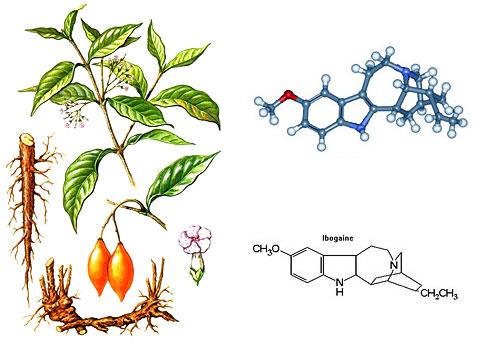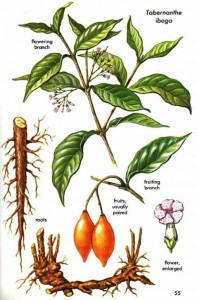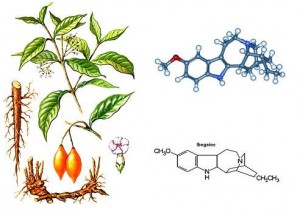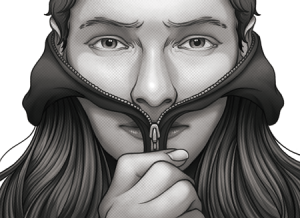Iboga (Tabernanthe iboga) has a long history of use as a medicine and spiritual sacrament in central Africa. The legend goes that the forest people first discovered it, through the observations of animals such as boar, porcupines and gorillas consuming the root. Iboga is used by the Bwiti in religious rituals, and it is used once a lifetime in a very large dose in an initiatory ceremony. The purpose of this initiation is for people to visit the spirit world and commune with the ancestors, and seek guidance for their lives. The inner root bark is the most alkaloid rich part of the plant. Iboga has become ever scarcer in Gabon due to increased Western interest and over harvesting. So when purchasing iboga it is important it be sustainably sourced from neighbouring countries such as Congo and Cameroon and one should check with suppliers.
Iboga is no pleasure trip. It lacks any kind of recreational attraction, and isn’t even intoxicating. Pleasure or thrill seekers look elsewhere. However, it has the capacity to be profoundly cleansing and therapeutic when used with care and respect.
Preparation
Iboga is dangerous in combination with many substances, so it is VERY important to abstain from all substances, including caffeine, for 24 hours prior to the experience. The combination with SSRI antidepressants could be lethal, and it is vital to have abstained from these at least 8 weeks prior to taking iboga, as these drugs have a long half life in the body. Iboga can affect the rhythms of the heart, so anyone with heart abnormalities should proceed with caution, or avoid altogether. Heart abnormalities can be screened for via ECG. People with impaired liver function should proceed with caution or avoid iboga altogether.
It is good to eat lightly on the day, and fast for 8 hours prior to the flood experience. Once you start consuming iboga you will soon lose your hunger or interest in food. One should drink water throughout the day, and a fresh vegetable juice is fine. A few hours prior to the experience stop drinking. You will be well hydrated now but excess water in the stomach when dosing impedes absorption of the iboga alkaloids. A few grams of root bark can be ingested over the course of the day, to gently introduce the iboga to your system and get it resonating with the plant. The Bwiti are known to consume iboga over a few days.
The effects of iboga can last up to 36 hours, and you’ll be lying down for this time, so best to be in or on a bed. Dizziness and nausea will strike if you move too suddenly, so move slowly when you need to. These feelings aren’t an issue when lying down. Prepare your space so it is clean and comfortable. Light and loud sounds will be intrusive while in an iboga trance. Have a bucket within arm’s reach from the bed as a purge is possible. The experience is not remotely sociable, and is deeply personal and internal, with the visions taking place behind closed eyelids, with the iboga inducing a waking dream state. So it may be best to begin flooding in the eve, and experience the visionary part at night. Candle light is soothing. Some people prefer silence, but recordings of Bwiti m’congo harp music is recommended, it is an important component of the rituals in Africa, and may assist with the brain defrag facilitated by iboga. Have water to hand, food is not necessary and you will likely not be interested in it until after the experience.
Ideally it would be best to consume iboga under the supervision of a healer or medical professional experienced with iboga. Such an approach can be highly expensive however. If people are still interested, it is very important to have someone trusted and understanding around such as a partner, friend or family member just to be safe if there any issues. You won’t have much need or desire to interact with other people during the experience. Iboga has a unique character in that it is both the experience and the guide.
Following the visionary period, there is a longer period of reflection and reintegration of lessons learned. The ibogaine is converted to noribogaine and as this builds up in one’s system it changes the experience, resulting in the prolonged afterglow, and very vivid tracers made by moving objects. One is in limbo between waking and sleeping. It can be good to have a few books on hand for the day after. The experience finally ends when one can fall asleep, and the dreams are likely to be vivid and visionary. The brain is reset during this time and one should feel good on waking and will be able to move around with dizziness or nausea. A shower or bath is recommended on waking, and you’ll likely be hungry.
Following the experience, the iboga is still working on you, it is highly lipophilic so hangs around in body tissues, gradually being released and converted into noribogaine by the liver. Ibogaine causes a long term increase in the expression of a protein called glial cell line-derived neurotrophic factor (GDNF) a neuroprotective agent that also induces neuronal sprouting. This aspect of long term effects makes iboga unique. Thus taking other drugs in the months after the experience will interfere with this process. Cannabis may be an exception to this, and has long been used in association with iboga in central Africa. Alcohol is safe but will reduce the healing influence of the iboga. Some people have used ayahuasca and kambo in the months afterwards and reported positive synergistic healing effects.
After the experience healthy eating, regular exercise, exposure to sunlight and nature will all augment and work with the healing and help ground one. Some people can feel quite blank in the days following a flood but this is normal as behaviour patterns and desires have been wiped clean, but this is temporary phase, and it can take a few days to really soar after an iboga experience.
If people are using iboga to treat addiction or change negative behaviour patterns, it is very important to enact life change prior to the experience, as this will help you get more from the experience, and make it easier to keep on a new path following the session. Iboga is not a panacea or magic bullet, it can only show you the door, and it is up to you to walk through it.
This is a good forum specialising in iboga and has lots of information on various aspects of the plant if anyone is interested in doing more research: Here
Microdosing
Microdosing with iboga can be another effective way of working with iboga and is a safe and controlled way of using the plant, which can be incorporated into day to day life. This is recommended for anyone who wishes to take a flood dose of iboga, so one can get a feel for the plant, and test for the extremely unlikely event of an allergic reaction. If consuming root bark, it is good to taste a little pinch of the plant first so you get a feel for the plant with all your senses. 500mg of root bark can be taken every four days as an anti-addictive and anti-depressant medicine (empty ‘00’ capsules work well for this). Doses much lower than this will be effective, as the effects are cumulative. It is important to taste a tiny pinch of the root bark, so all your senses are able to experience the plant. Total alkaloid (TA) extract can be used in the form of a tincture sublingually, which is a highly efficient way of using it, being absorbed directly into the bloodstream. In whatever form the iboga is used, it is important to state a positive affirmation, as this intent will direct the iboga’s healing to where it is needed.
A detailed guide on iboga microdosing can be found on the Eboka forums.
Flooding
For flooding I would recommend using TA extract. It has all the benefits of the ‘whole plant’ experience of the root bark, containing the full spectrum of alkaloids, but is much easier to dose with, and seems a lot easier and smoother on the body It is also much cheaper than purchasing alkaloid extracts or pure ibogaine online. TA produces much less dizziness than the root bark, and it is easier to move around on it. It easier to go deeper on it than the root bark, requiring much less material to be consumed. The other alkaloids work with the ibogaine to prolong, deepen and augment its influence, and are a welcome addition. Pure ibogaine seems to wash through the system more quickly, producing less of an afterglow than with TA or root bark.
It is recommended to save a few grams of root bark to ingest alongside the TA, to give an essence of the whole unadulterated plant. Some people like to stagger dosing, and take some every 30 minutes until the whole dose is consumed. I have found taking one capsule of TA, and then splitting the rest of dose in halves and taking 45 minutes apart works well. For people treating addiction, it can be worth keeping a little TA extract or root bark for use as booster doses in the months post session to prolong the window of iboga’s influence.
If people wish to work with the root bark, it is best to consume a gram every 40 minutes or so until the dose is consumed, or there is a purge or one believes enough has been consumed. Putting powdered root bark in capsules works well for this but it is important to taste a tiny pinch so all your sense experience the plant.
Once you flood it is important not to take another flood dose in the three months afterwards as this can be dangerous, due the residual noribogaine in one’s system. Taking small booster doses in this time frame of TA or root bark is fine.
TA Preparation
25g of root bark is sufficient quantity for a flood per person, although potency and individual sensitivities vary, for others half this amount may be sufficient. The root bark is ground into a powder (a coffee grinder works well for this). The powder is added to a large jar, containing a good amount of distilled white vinegar. This is simply kept for five days to a week and shaken a few times a day. The vinegar will become dark from all the alkaloids, and this first extraction will pull the vast majority of the alkaloids. Filter this solution with a cotton shirt or with a coffee filter, and keep the liquid. A bottle with a funnel and a coffee filter works well for filtering. Scrape the iboga back into the jar, add more vinegar and repeat the process, twice more for a duration of two days each time. If you want you can then bury the depleted root bark in the soil and return it to the Earth from whence it came.
The vinegar extractions can be combined, poured into a glass baking dish and placed in the oven. Heat at 200°F with the oven door open with regular checking. When dry, bring out and allow to cool, and then scrape up with a knife. It can be wrapped in foil and frozen for long term storage or placed into empty ‘00’ capsules ready for use.
If someone is in more of a rush to extract the alkaloids, the root bark can be covered in distilled vinegar and simmered on low heat for 60-90 minutes, then filtered and the liquid kept aside, and this process is repeated 3 times.
Guide for Iboga Use,






peaceandlove
16 Jun 2014OMG, another herbal remedy…..I’ll wait till next week for the new hot herbal remedy that creates total life bliss.
Samwise
16 Jun 2014This is a classic armchair skeptic response to something they clearly know very little about. Iboga has been used as a medicine and spiritual sacrament for many hundreds, quite possibly thousands of years. It’s very impressive and unique effects on breaking, or interrupting drug addiction is well documented and research is currently ongoing. The experience is not for that faint hearted, you will be confronted with aspects of your shadow, and you will be humbled…the experience is very far removed from anything remotely recreational, or blissful. What it can do is show you negative behavioural patterns or aspects of your life you may wish to change. My first experience with this plant was one of the most amazing things I have ever experiences and the insights I gained have remained with me and continue to affect me in a positive way today. Plants like iboga, used well, have a tremendous capacity for good.